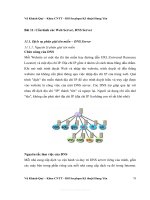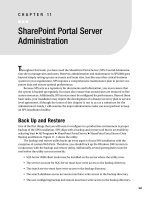Web server administration chap04
Bạn đang xem bản rút gọn của tài liệu. Xem và tải ngay bản đầy đủ của tài liệu tại đây (509.56 KB, 35 trang )
Web Server Administration
Chapter 4
Name Resolution
Overview
Understand the domain name service (DNS)
Identify the components of DNS
Configure zone files
Install and configure DNS in Linux
Understand name resolution in Windows
Install and configure DNS in Windows 2000
and 2003
Troubleshoot DNS
Use WINS to resolve computer names in
Windows
Understanding the DNS
DNS is used to map host names to IP addresses
on the Internet
Also called name resolution or address resolution
Whenever a host is added, a configuration file has to be
manually changed
A host represents a service on a server such as FTP or a Web
server
There can be many hosts on a single computer
A Microsoft Windows 2000 or Windows 2003
network uses DNS to resolve computer names
on a LAN
DNS in Windows is designed to be dynamic - as computers are
added to the network, DNS automatically changes
Clients
On your PC, the TCP/IP configuration contains the
address(es) of your DNS server(s)
Whenever you use a URL, whether in a browser, or a
utility such as ping, DNS servers are used
Domain Namespaces
The root level domain is "."
Top-level domains include com, org, fr
More have been added in 2000
Second-level domains are often owned by
companies and individuals
Significant in creating DNS files
microsoft.com, devry.edu
A subdomain is a further division of a secondlevel domain
For devry.edu, there is phx.devry.edu
Not common
Domain Namespaces
Second-level domains, such as devry.edu
have control over naming within their
domain
Create hosts such as www, ftp, bb
A name such as www.devry.edu is a fully
qualified domain name (FQDN)
We could create subdomains such as phx
www.phx.devry.edu
New Top-Level Domains
.biz - businesses
.info - anyone can register
.name - must register first and last name
.pro - for professionals only
must provide proof
.aero, .museum, .coop are controlled by organizations
Host Names
The first portion of a URL is typically a host name
Typically different from the name of the computer
Many hosts can be associated with the same Web
server
How DNS Works
DNS Components
Name server – also known as DNS server
supports name-to-address and
address-to-name resolution
Name resolver – also called DNS client
Can contact DNS server to lookup
name
Used by browsers, e-mail clients, and
client utilities such as ping and tracert
DNS Servers that Define the
Internet
Primary and secondary servers store the host names
used on the Internet
Caching and forwarding servers search the Internet for
host names
Primary and Secondary
Servers
Primary Server
Defines the hosts for the domain
Maintains the database for the domain
It has authority for the domain
Secondary Server
Gets data from primary server
Provides fault tolerance and load
distribution
Required for Internet domains
Primary and Secondary
Servers
If you use DNS, you will often work with
your ISP
In a simple environment, the ISP will
have the primary and secondary DNS
servers
You contact them for changes
You can also split the servers
ISP has primary, you have secondary
You have primary, ISP has secondary
Primary and Secondary
Servers
ISP maintains DNS
You have to send changes to ISP
You have the secondary server which gets updates from
the primary server
Your users reference your secondary server which is faster
Primary and Secondary
Servers
You have complete control over DNS
You can make changes whenever you want
If your primary DNS goes down, the secondary will
continue to function (but not indefinitely)
Resolve Host Names
Caching Server
Resolves host names
Caches (saves) the results
Automatically installed when DNS is installed
No configuration necessary
Forwarding Server
Caching server that has access to the
Internet and forwards traffic from other
caching servers
Caching and Forwarding Servers
Zones
A zone is a part of the domain
namespace
For a domain as small as
technowidgets.com, the domain name
represents a single zone
For large organizations (such as IBM),
subdomains can be divided into
separately maintained zones
Each zone typically has a separate DNS
Zones
Zones must be contiguous
admin.devry.edu can be combined with
devry.edu
admin.devry.edu cannot be combined with
student.devry.edu
There must be one primary DNS server
in each zone (plus a secondary server)
Each zone can have multiple secondary
DNS servers
Zone File Configuration
Forward Lookup
These zones contain entries that map
names to IP addresses
Reverse Lookup
These zones contain entries that map
IP addresses to names
Common DNS Records
DNS record
Function
Address (A)
Associates a host to an IP address.
Canonical
name (CNAME)
Creates an alias for a specified host.
Internet (IN)
Identifies Internet records; precedes most DNS record
entries.
Mail Exchanger
(MX)
Identifies a server used for processing and delivering
e-mail for the domain.
Name server
(NS)
Identifies DNS servers for the DNS domain.
Pointer (PTR)
Performs reverse DNS lookups. Resolves an IP address
to a host name.
Start of
Authority
(SOA)
Identifies the DNS server with the most current
information for the DNS domain.
DNS Configuration in Linux
/etc/named.conf describes the files that
configure the zones
There are two primary files that it describes
Forward lookup is described by
named.technowidgets.com
It has the host names and how to handle e-mail
Reverse lookup is described by named.0.168.192
Can be necessary for e-mail (SMTP) and security
programs
/etc/named.conf
Creating a DNS for the technowidgets.com
domain
Default setup is for localhost 127.0.0.1
In named.conf add the following line
zone "technowidgets.com" {
type master;
file “named.technowidgets.com”;
};
This allows technowidgets.com to be
resolved by
/var/named/named.technowidgets.com
There can be multiple domains in a single
named.conf file
/etc/named.conf
Also, we can add the following line
zone “0.168.192.in-addr.arpa” IN {
type master;
file “named.0.168.192”;
};
This allows for reverse lookup for the
domain
It uses all or part of the 192.168.0.0
network
/
var/named.technowidgets.co
$TTL
86400
@
m( IN SOA web1.technowidgets.com. admn.technowidgets.com.
2002072100 ; Serial
28800
; Refresh
14400
; Retry
3600000 ; Expire
86400 ) ; Minimum
IN
NS
web1
IN
A
192.168.0.100
IN
MX 10 mail.technowidgets.com.
web1
IN
A
192.168.0.100
www
IN
CNAME web1
research
IN
A
192.168.0.150
IN MX 10 mail
IN
A
192.168.0.200









